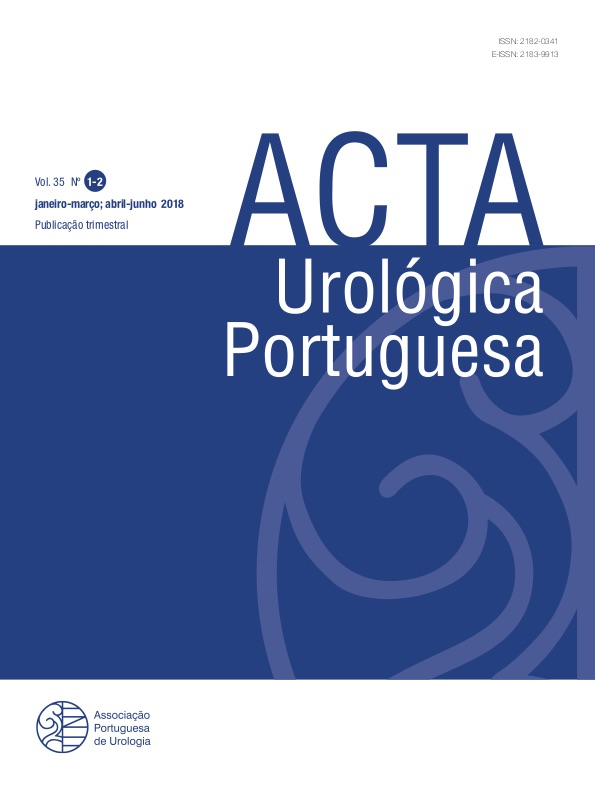Transrectal Prostate Biopsy After Prophylatic Preparation of the Rectum with Povidone-Iodine: A Prospective Randomized Trial
DOI:
https://doi.org/10.24915/aup.35.1-2.51Palavras-chave:
Aspiração por Agulha Fina Guiada por Ultrassom Endoscópico, Biópsia, Profilaxia Antibiótica, PróstataResumo
Introdução: A biópsia prostática transrectal (BPTR) ecoguiada, de acordo com a literatura actual, pode causar infecções do trato urinário em até 11% e sepsis em até 2% dos pacientes. Avaliamos a capacidade de uma forma original de preparação retal com iodo-povidona peri-procedimento (BPTR ecoguiada) poder reduzir complicações infecciosas.
Material e Métodos: Entre janeiro de 2014 e setembro de 2016, num estudo prospetivo e randomizado realizado num consultório privado, 94 homens foram divididos em dois grupos, antes da BPTR ecoguiada: • Com preparação rectal (uma original massagem prostática transrectal por cerca de meio minuto com 2,5 mL de betadina dérmica 100 mg/mL) (n=47) • Sem preparação (n=47). Todos os doentes receberam antibiótico profiláctico: levofloxacina 500 mg PO durante sete dias, iniciado no dia anterior ao procedimento. Os pacientes completaram uma entrevista por telefone quatro dias após a realização da biópsia e foram ao consultório médico duas semanas após a biópsia. O objectivo primário foi a comparação da taxa de complicações infecciosas Foi considerada complicação infecciosa a ocorrência de um ou mais dos seguintes eventos: 1) febre superior a 38,0ºC, 2) infecção do trato urinário ou 3) sépsis (definição padronizada). Foi utilizado o teste t de Student e a análise de regressão multivariada no estudo dos dados.
Resultados: No grupo sem preparação rectal, seis pacientes (12,7%) tiveram complicações infecciosas: cinco apresentaram febre sem sépsis (11%) e um evoluiu com sépsis (2%). No grupo da preparação rectal com iodo-povidona solução dérmica não se registaram complicações infecciosas (0,0%). A análise multivariada não identificou nenhum subgrupo de pacientes com risco significativamente maior de infecção após a biópsia da próstata. Dos 94 homens que foram submetidos a BPTR ecoguiada, 45 (47,9%) foram diagnosticados com cancro da próstata e 3 (3,2%) apresentaram ASAP no resultado. A taxa de admissão hospitalar por complicações urológicas no prazo de 30 dias do procedimento foi de 1%, e apenas por razões relacionadas com infecção (sépsis).
Conclusão: A administração de antibióticos profiláticos à base de quinolonas e a simples aplicação de 2,5 mL de solução de iodo-povidona através de uma massagem transrectal da próstata por cerca de meio minuto proporcionaram um excelente protocolo para reduzir as complicações infecciosas da BPTR ecoguiada.
Downloads
Referências
2. Machado MT, Verotti MJ, Aragao AJ, Rodrigues AO, Borrelli M, Wroclawski E. Prospective randomized controlled trial comparing three different ways of anesthesia in TRUS guided Prostate Biopsy. Int Braz J Urol. 2006;32:172-80.
3. Nash PA, Shinohara K. TRUS guided prostatic nerve blockade eases systematic needle biopsy of the prostate. J Urol. 1996;155: 607-9.
4. Soloway MS, Obek C. Periprostatic local anesthesia before ultrasound guided prostatic biopsy. J Urol. 2000;163:172-3.
5. Cadilhe JP. TRUS prostatic Biopsy: the role of the Urologist step by step. J Endourology. 2006;20:170.
6. Autorino R, De Sio M, Di Lorenzo, Damiano R, Damiano R, Perdonà S, Cindolo L, et al. How to decrease pain during TRUS guided biopsy: a look at the literature. J Urol. 2005;174:2091-97.
7. Scattoni V, Zlotta A, Nava L, Rosigno M, Montorsi F. TRUS guided biopsy schemes and TRUS prostatic lesion guided biopsies. Eur Urol. 2002:Supl;28-34.
8. Rocco B, de Cobelli O, Leon ME, Ferruti M, Mastropasqua MG, Matei DV, et al. Sensitivity and detection rate of a 12-core trans-perineal prostate biopsy: preliminary report. Eur Urol. 2006;49:827-33.
9. Eskicorapci SY, Baydar DE, Akball C, Sofikerim M, Günay M, Ekici S, et al. An extended 10-core TRUS prostate guided biopsy protocol improves detection of prostate cancer. Eur Urol. 2004;45 444-9.
10. Emiliozzi P, Scarpone P, DePaula F, Pizzo M, Federico G, Pansadoro A, et al. The incidence of prostate cancer in men with PSA greater than 4,0 ng/ml: a randomized study of 6 versus 12 core transperineal prostate biopsy. J Urol. 2004;171:197-9.
11. Ravery V, Goldblatt L, Royer B, Blanc E, Toublanc M, Boccon-Gibod L. Extensive biopsy protocol improves the detection rate of prostate cancer. J Urol. 2000;164:393-6.
12. Gore JL, Shariat SF, Miles BJ, Kadmon D, Jiang N, Wheeler TM, et al. Optimal combinations of systematic sextant and laterally directed biopsies for the detection of prostate cancer. J Urol.2001;165:1554-9.
13. Chang JJ, Shinohara k, Bhargava V, Presti JC. Prospective evaluation of lateral biopsies of the peripheral zone for prostate cancer detection. J Urol. 1998;160:2111-4.
14. Terris MK, Wallen EM, Stamey TA. Comparison of mid-lobe versus lateral systemic sextant biopsies in detection of prostate cancer. Urol Int. 1997;59:239-42.
15. Cadilhe JP, Veiga da Silva. Esquemas de biopsias prostaticas transrectais ecoguiadas e BPTR dirigidas a lesões. Acta Urol Port. 2007, 24;2:66.
16. Hodge KK, McNeal JE, Terris MK, Stamey TA. Random systematic versus directed ultrasound guided transrectal core biopsies of the prostate. J Urol. 1989;142:71-4.
17. Kuligowska E., Barish MA, Fenlon HM, Blake M. Predictors of prostate carcinoma: accuracy of gray scale and color doppler US and serum markers. Radiology. 2001;220:757-64.
18. Iczkowski KA, Casella G, Seppala RJ, Jones GL, Mishler BA, Qian J, et al. Needle core length in sextant biopsies influences prostate cancer detection rate. Urology. 2002;59:698-703.
19. Cadilhe JP. Transrectal prostate biopsy after prophylatic preparation of the rectum with povidone-iodine – A prospective randomized trial. J Urol. 2017;197:e143.
20. Carey JM, Korman HJ. Transrectal ultrasound guided biopsy of the prostate. Do enemas decrease clinically significant complications? J Urol. 2001; 166:82-5.
21. Zaytoun OM, Anil T, Moussa AS, Jianbo L, Fareed K, Jones JS. Morbidity of prostate biopsy after simplified versus complex preparation protocols: assessment of risk factors. Urology. 2011; 77:910-4.
22. Grabe M, Bjerklund-Johansen T, Botto H, et al. Guidelines on urological infections. European Association of Urology website [accessed April 2016] Available from: http://uroweb.org/wp-content/ uploads/18_Urological-infections_LR.pdf.
23. Hwang EC, Jung SI, Seo YH, Jeong SH, Kwon DD, Park K, et al. Risk factors for and prophylactic effect of povidone-iodine rectal cleansing on infectious complications after prostate biopsy: a retrospective cohort study. Int Urol Nephrol. 2015; 47:595-601.
24. Murphy DG, Weerakoon M, Grummet J. Is zero sepsis alone enough to justify transperineal prostate biopsy? BJU Int. 2014; 114:3-4.
25. Grummet JP, Weerakoon M, Huang S, Lawrentschuk N, Frydenberg M, Moon DA, et al. Sepsis and ‘superbugs’: should we favour the transperineal over the transrectal approach for prostate biopsy? BJU Int. 2014; 114:384-8.
26. Loeb S, Carter HB, Berndt SI, Ricker W, Schaeffer EM. Complications after prostate biopsy: data from SEER-Medicare. J Urol. 2011;186:1830-4.
27. Akduman B, Akduman D, Tokgöz H, Erol B, Türker T, Ayoglu F, et al. Long-term fluoroquinolone use before the prostate biopsy may increase the risk of sepsis caused by resistant microorganisms. Urology. 2011; 78:250-5.
28. Wagenlehner FM, van Oostrum E, Tenke PG, GPIU investigators. Infective complications after prostate biopsy: outcome of the Global Prevalence Study of Infections in Urology (GPIU) 2010 and 2011, a prospective multinational multicentre prostate biopsy study. Eur Urol. 2013;63:521–7.
29. Walker JT, Singla N, Roehrborn CG. Reducing infectious complications following transrectal ultrasound-guided prostate biopsy: a systematic review. Rev Urol. 2016;18:73–89.
30. Womble PR, Linsell SM, Gao Y, Ye Z, Montie JE, Gandhi TN, et al. A statewide intervention to reduce hospitalizations after prostate biopsy. Urological Surgery Improvement Collaborative. J Urol. 2015; 194:403-9.
31. Lorber G, Benenson S, Rosenberg S, Gofrit ON, Pode D. A single dose of 240 mg gentamicin during transrectal prostate biopsy significantly reduces septic complications. Urology. 2013; 82:998-1002.
32. Losco G, Studd R, Blackmore T. Ertapenem prophylaxis reduces sepsis after transrectal biopsy of the prostate. BJU Int. 2014; 113 (Suppl 2):69-72.
33. Issa MM, Al-Qassab UA, Hall J, Ritenour CW, Petros JA, Sullivan JW. Formalin disinfection of biopsy needle minimizes the risk of sepsis following prostate biopsy. J Urol. 2013;190:1769–75.
34. Park DS, Hwang JH, Choi DK, Gong IH, Hong YK, Park S, et al. Control of infective complications of transrectal prostate biopsy. Surg Infect. 2014; 15:431-6.




